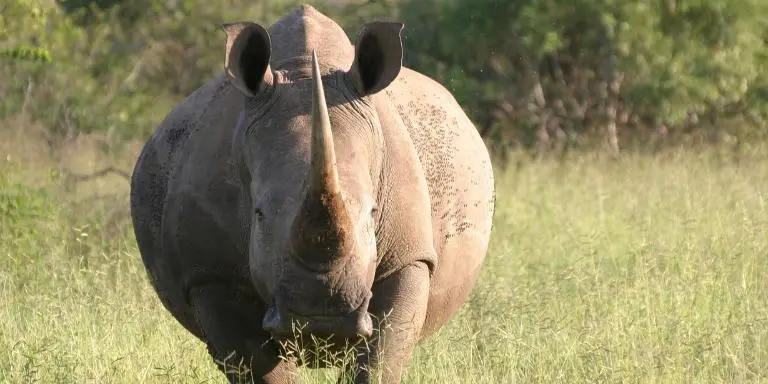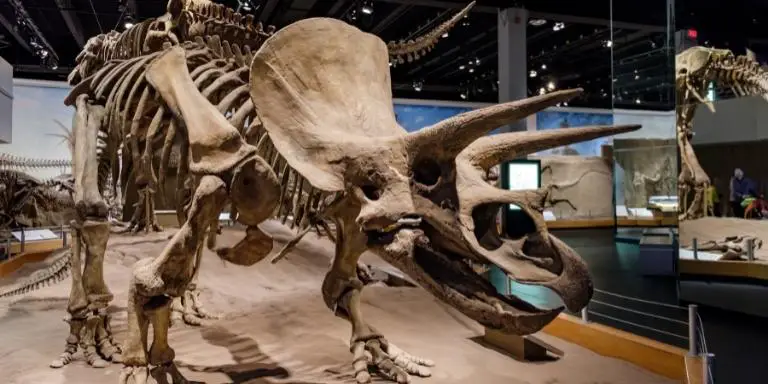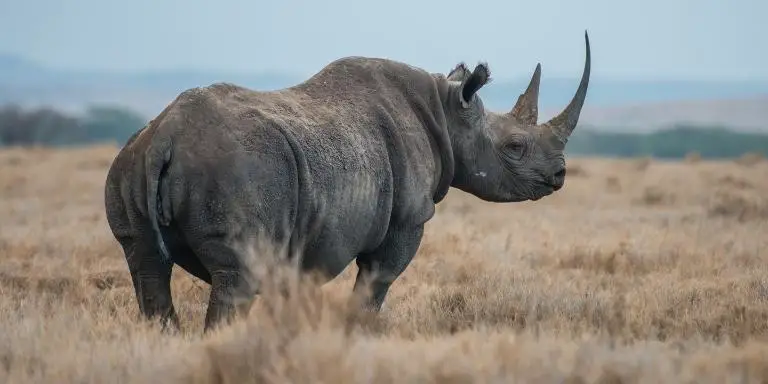The modern rhinoceros looks a lot like the prehistoric dinosaurs. Since the first discovery of the fossils of the ancient dinosaurs, people have raised questions. Is the rhino a dino? Or is it somehow related?
But later on, scientists proved that this is a mere imagination of the human mind. Because the rhino has no such connection with the dino, but that didn’t puncture the balloon of people’s high interest. Imagine a fight between Triceratops vs. Rhino. Imagine the monstrosity of the battle. Which side is more likely to be the winner? The statistics are heavier on the triceratops side.

Triceratops vs Rhinoceros – Comparison table
| Comparison with | Triceratops | Rhinoceros |
|---|---|---|
| Scientific classification | Triceratops | Rhinocerotidae |
| Class | Reptile | Mammal |
| Size | The triceratops can be compared to a full-grown African elephant. Its length used to grow up to 30 feet or 9 meters. The massive thing was about 10 feet tall. It had the largest head ever that, was about 1/3rd of the whole body. The head alone was about 8.2 feet long. | The average height of the rhinocerosis about 5.5 to up to 6.5 feet. The length of the body is about 11 to 14 feet. However, the White species are the biggest ones in today’s world. They grow up to 12 to 14 feet long and about 6 feet tall from hoof to shoulder. |
| Weight | The Triceratops weighed around 5400 to 8000 kg (approximately 11800 pounds to 16000 pounds) | An adult rhino can weigh up to 2500 kilograms. Anyhow, their weights can vary from 1600 to 4000 kilograms depending on the species and age. |
| Color | Scientists couldn’t confirm the color of the triceratops with confidence. All we know about them comes from fossils. And fossils only have bones and no skins. So there is no proof of the exact color of their skin. scientists do not find any dinosaur skins underneath the earth. However, many suggest that the skin of the Triceratops was the same as the human skin and hair color. Others say that it probably had some camouflage by being the same color as the contemporary environment. | Most rhinoceroses are grayish-brown. Some are yellowish-brown. |
| Body | Triceratops had a vast, bulky body, column-like legs, claws that looked like hooves, a short neck, a big head, and a relatively short and pointed tail. The mouth looked like a parrot beak and had many teeth. They also had three big horns and a gigantic frill on the back of their neck. All of it was made of bone and covered in Keratin. | The rhinoceros has a large bulky body. Their chest is broad, and their feet are strong enough to carry immense weight. Each foot has an odd number of hooves. The short neck follows a larger head right at the front of the animal. Their eyes are small, and their pointy ears stick out from the two sides of the face. They also have a little tail. |
| Mouth | Triceratops had a beak-shaped mouth that looked like a parrot’s beak. It had about 800 teeth. All of them were molars and premolars and were arranged in groups called batteries. The mouth was better suited for grasping and plucking, which explains it is vegetarian. | Black rhinos have a pointy upper lip that helps them to grasp something. In contrast, the white ones have a flatter upper lip. The rest of the 3 Asian rhinos also have prehensile lips like their black contemporaries. Their mouths contain 24 to 34 teeth. Most of them are grinding teeth. |
| Horn | Triceratops had three powerful horns. One was on the nose, just like the rhinoceros. It was relatively smaller than the other two that stuck out from above the eyes. The bigger ones were pointy and bent. The horns were made of bone and covered in Keratin. They used to grow up to 3 feet long. The frill on the back of the head helped the horns to stay in place. It also allowed the beast to carry the load of the massive head. | Rhinoceroses have single or double horns, depending on the species. The 2 African ones have dual horns each, and the rest of the Asian ones have a single one on the nose, except for the Sumatran one. They also have double horns despite being Asian. |
| Diet | Triceratopses were herbivores. They liked mainly eating shrubs and other forms of plant life. They also lived on Palms, Cycads, and Ferns. | Rhinoceroses are herbivores and live entirely on plants. They consume about 54 kilograms of plants, grass, twigs, leaves, bushes, berries, green branches, roots, etc every day. |
| Speed | The maximum speed was 32 kilometers per hour. | Maximum speed belongs to the Indian rhino. They are incredibly agile animals and can run up to 55 kilometers per hour. |
| Behavior | Triceratops are considered to be pretty aggressive dinosaurs. They used to live in groups and moved as a herd. They lived on different kinds of vegetation. The young ones were kept on the inside of the pack for protection. However, they ended up in fights with other carnivorous dinos at times. It was confirmed by fossil experts that found injuries on the horns and bones of the fossils. | They are solitary yet territorial. They dislike trouble and would run you off if they could smell it on you. They like to charge at things. The horn is their favorite, and they never hesitate to use it—no wonder why the potential predators feel unsafe in a rhino-infested area. |
| Habitat | Dry and forest areas where herbs were abundant. The world of 68 million years ago was different from what we see today. Most of the rhino fossils were discovered in North America and Canada. | The African rhinos live in plain grasslands containing flooded earth at intervals. Indian ones live in swamps and rainforests. Sumatran and Javan species also live in rainforests but a bit further from India. They are found in Malaysia and Indonesia. |
| Conservation status | Extinct | Black rhinoceros are ” critically endangered”. The Indian ones are “vulnerable”. White species are “near threatened”. Finally, the Sumatran and Javan rhinos are also hanging on the brink of extinction. Their numbers are decreasing day by day. |
| Population | The exact number of how many of the Jurassic being walked on earth is still unknown. Nonetheless, more than 50 fossils were discovered across the world. | There were 500,000 rhinoceroses worldwide at the beginning of the 20th century. But today, only 29,000 of them remain. |
Which Dinosaur That Looks Like a Rhino

Triceratops is the dinosaur that looks most like the rhinoceros if we ignore the extra horn. However, there is another dino similar to them called the Centrosaurus.
Their similarities are astounding. Yet they are not related in any way. The rhino is a mammal, whereas the dino is a reptile.
The Rhinos bear their children, and the dinos used to hatch eggs. The rhinos have thick skin with hair and tissues, whereas the dinosaurs have scales on their bodies.
Again, both of their horns are used for self-defense. But the material of the spikes is not the same. The rhino horns are made of Keratin; In contrast, the dino horns are made of bones with a layer of Keratin on the top. But surprisingly, both are herbivores.
Firstly, everything we know about the Triceratops comes from fossil findings. None of them are alive today. So all the data we discuss might change or get modified in the future with further discoveries.
Yet we know quite a lot about the family history of Triceratops. The Triceratops belonged to the Ceratopsidae family. Most of their remains were found in the USA, Canada, and Mexico. Though they were non-avian dinos, they had beak-shaped mouths. It proves that modern birds have emerged from them and their families are related.
Scientists claim them to be the most successful herbivores of all time. Horns and frills made of bones are the most distinguishing feature of the species. These are the things that connect them with rhinoceroses in a physical sense. Though both of their features include rough skin, large horns, bulky bodies, etc., they are different from one another.

The rhinoceros belong to the Rhinocerotidae family. When their species first appeared, the Triceratops was already ruling the jungles. The rhino is more recent, and they seemed only about 5 million years ago. Where the dinosaurs are related to birds, the rhinoceroses are closer to ungulates such as zebras, horses, and tapirs.
Who Would Win the Fight Between Triceratops vs Rhino?

There are many theories regarding the imaginary battle. But most of them assure the win of the Triceratopses. Though the rhinoceroses are more agile, the Triceratopses are too big to avoid.
One blow from the Triceratops can result in fatal injuries for the rhino.
The dinos with horns were the most to be feared. Because they simply used to gore their opponent to death. And though the Triceratops were friendly and a lot less aggressive, they were not to be played with. They loved their young ones and would protect them with any means necessary.

The statistics are also heavy on the triceratops’ side. The Jurassic creature was about 10 feet tall, which is nearly double the height of today’s rhinos. The weight difference is also astounding. The prehistoric being weighed from 5400 to 8000 kilograms while the present-day rhino is around 2500 kilograms on average.
The distinguishing features are evident here. The triceratops is stronger, bigger, and heavier. The only upper hand today’s rhinos have is their agility. That is also not of much help as the Triceratops were quite agile. Their pole-like feet helped them to carry their weight with ease.
Conclusion
The triceratops vs rhinos battle would be epic. The only thing is it can never happen. But still, human curiosity keeps the discussion alive. The result would be pretty obvious. The Triceratops would win by going and stomping the rhino to death. The only way the result could differ is if the rhino can catch a fatal blow in any sensitive parts of the triceratops using its agility.
You might also be interested in:
- Rhino vs Hippo | Who Would Win in a Fight?
- Elephant vs Hippo | Who Would Win in a Fight?
- Hippo vs Crocodile | Who Would Win in a Fight?
- Rhino vs Lion | Who Would Win in a Fight
- Rhino vs Elephant | Fierce Combat in The Wild
- Rhino vs Tiger Who Would Win in a Fight?
- Rhino vs Crocodile Who Would Win in a Fight?
